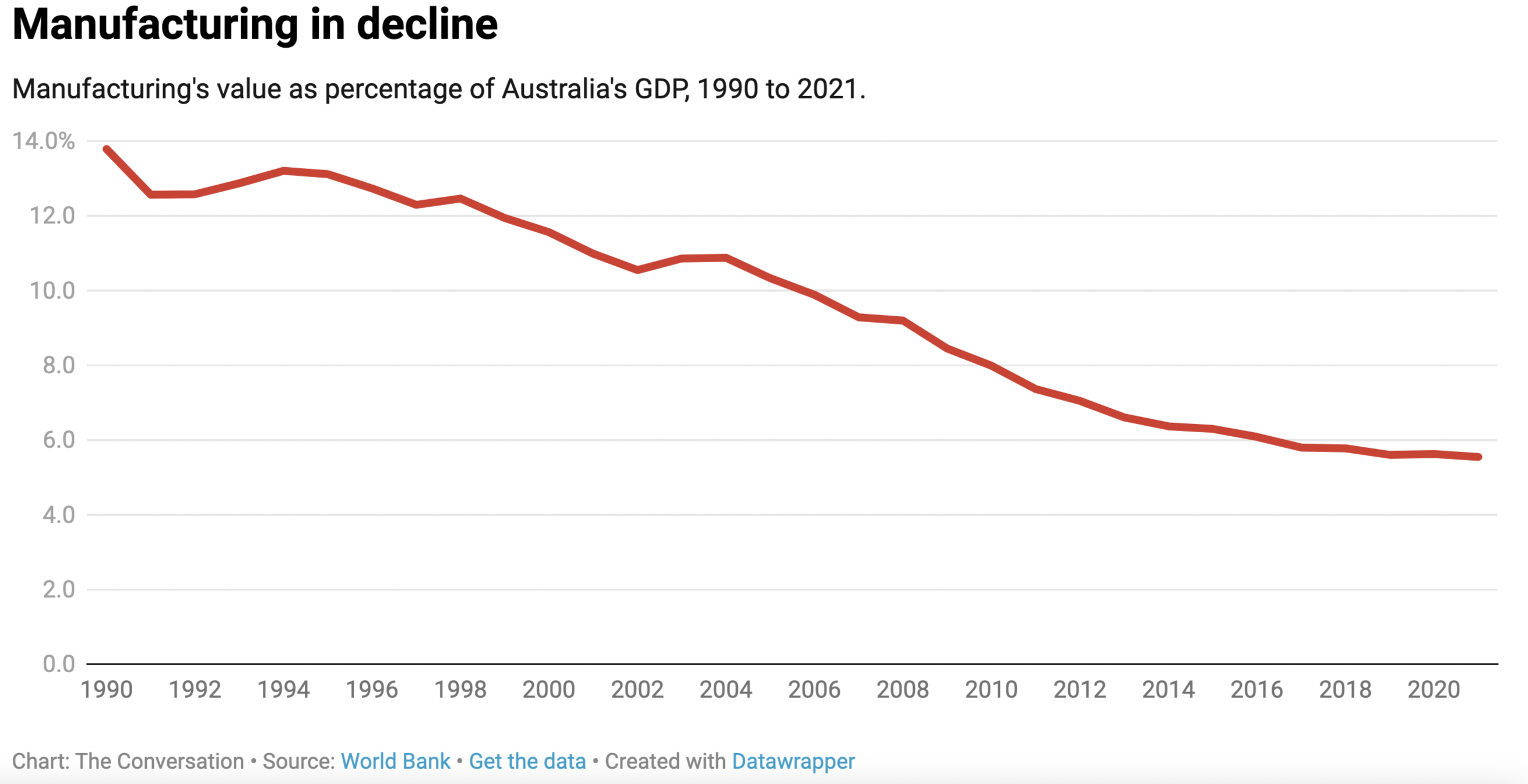How the $15 billion National Reconstruction Fund will transform high-tech manufacturing – and 3 things to make it better
Australia’s federal parliament has approved a A$15 billion National Reconstruction Fund, intended to reverse the nation’s dwindling manufacturing sector. It is the “first step” in Prime Minister Anthony Albanese’s election promise “to revive our ability to make world-class products.”
The fund will focus on investing in high-tech manufacturing. There are seven priority areas:
- clean energy
- medical science
- transport
- value-added manufacturing in agriculture, forestry, and fisheries
- value-added manufacturing in mining
- military equipment, and
- “enabling capabilities.”
The fund is expected to operate commercially and deliver a return on its investments. Its approach will be similar to the Clean Energy Finance Corporation, which over the past decade has provided more than $10 billion in grants and loans to low-emission energy projects.
Investments will be in the form of loans, equity and guarantees. It will be a co-investment model, meaning private investors will have to match funds provided.
It will start with $5 billion. The other $10 billion will provided in instalments over the rest of the decade. After 2030, investments are expected generate enough revenue to support new projects. These decisions will be made by a board that will be independent of the federal government.

Manufacturing data
Criticisms of the fund
There is support for the fund from employer groups and trade unions. But there are also criticisms.
More broadly, some economists argue government-supported investment schemes misallocate resources, give certain businesses an unfair advantage, and slow down innovation over time by investing too much in one area and starving other innovative ideas of resources. As The Economist has put it, trying to “pick winners” can also mean investing in losers.
But government-backed investments do play a crucial role in providing financial support to commercialise new technology, for which attracting private investment is typically tough.
The federal opposition has complained the Albanese government should focus on more immediate challenges facing manufacturers, such as high energy prices and labour shortages.
Opposition frontbencher Paul Fletcher has expressed concern the fund will finance projects that “would not succeed in getting private sector finance – but which for political reasons the government wants to fund”. A factory in a marginal seat, for example.
There are precedents for such concerns. The Morrison government, of which Fletcher was a senior member, did such things with funding for car parks and sporting facilities.
But it is also the case that such pork barrelling didn’t happen with the Morrison government’s $1.3 billion Modern Manufacturing Initiative, which provided grants in roughly the same priority areas as the new fund.
Despite political and financial incentives to find fault with it, the Albanese government has endorsed the Modern Manufacturing Initiative’s expenditure. It has criticised only the way the Morrison government manipulated the timing of funding announcements.
Nor has the Clean Energy Finance Corporation, established by the Gillard government in 2012, faced such criticisms. It is regarded as a success story across the political spectrum, from groups such as the Australian Conservation Foundation to mining magnate Clive Palmer.
The establishment of the National Anti-Corruption Commission should further give confidence that Albanese, a longtime champion of making things in Australia, is sincere about “complete transparency” for the National Reconstruction Fund.
3 ways to improve the fund
To but to improve the fund’s chance of success, there are three things that can be done.
First, to achieve the transparency Albanese has promised, the fund should publicly share the reasoning behind its investment decisions, similar to how the Reserve Bank of Australia’s board publishes minutes of its monthly policy meetings. Being open about decision-making will build public trust in the fund’s transparency and fairness.
Second, the National Reconstruction Fund’s investment board will need to clearly outline investment priorities while staying flexible, so projects that span multiple sectors or applications don’t fall between the cracks. Breakthrough ideas may not fit neatly into a single category. For instance, synthetic biology technology can be used in food manufacturing and plastic recycling. It doesn’t belong to just one priority area.
Third, supporting individual projects isn’t enough. Here’s where those “enabling capabilities” are crucial. Changing the trajectory of manufacturing in Australia requires a supportive ecosystem that aligns things like funding and policy priorities in education and training, research being done in universities, immigration settings, and natural advantages.
Projects won’t succeed without skilled workers, strong research backing, and easy access to suppliers and customers.
Australia’s renewable energy sector is an example of a supportive environment that can lead to success. Australia has plenty of sun and wind, a growing number of skilled workers in the renewable energy field, top research institutions, a knowledgeable investor base thanks to the Clean Energy Finance Corporation, and a growing number of people who care about eco-friendly energy solutions.
By setting clear goals, encouraging innovation, and making decisions transparent, the fund stands the best chance to achieve what it has been created to do.
Credit: Source link


Comments are closed.